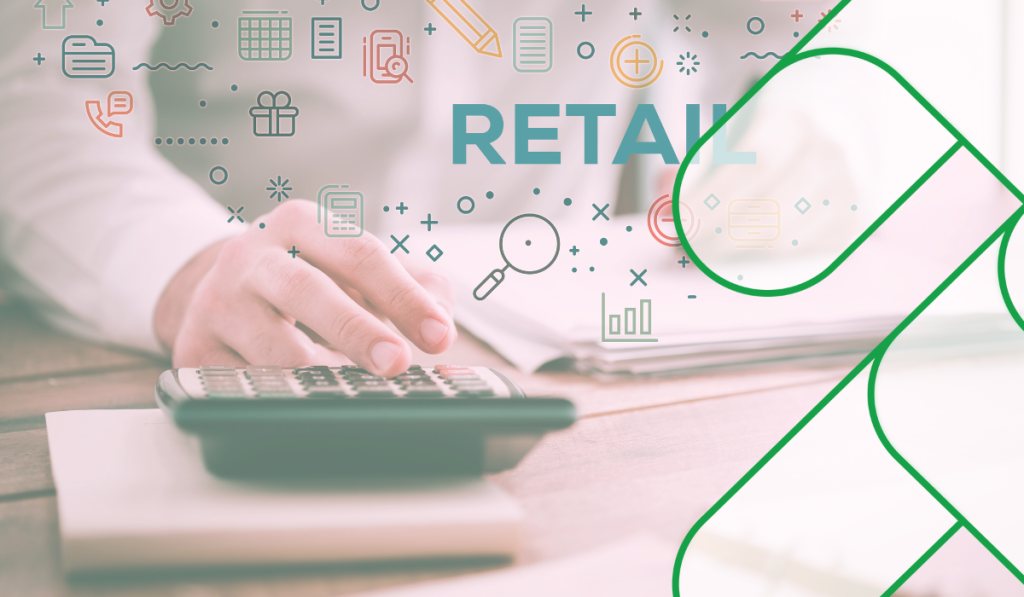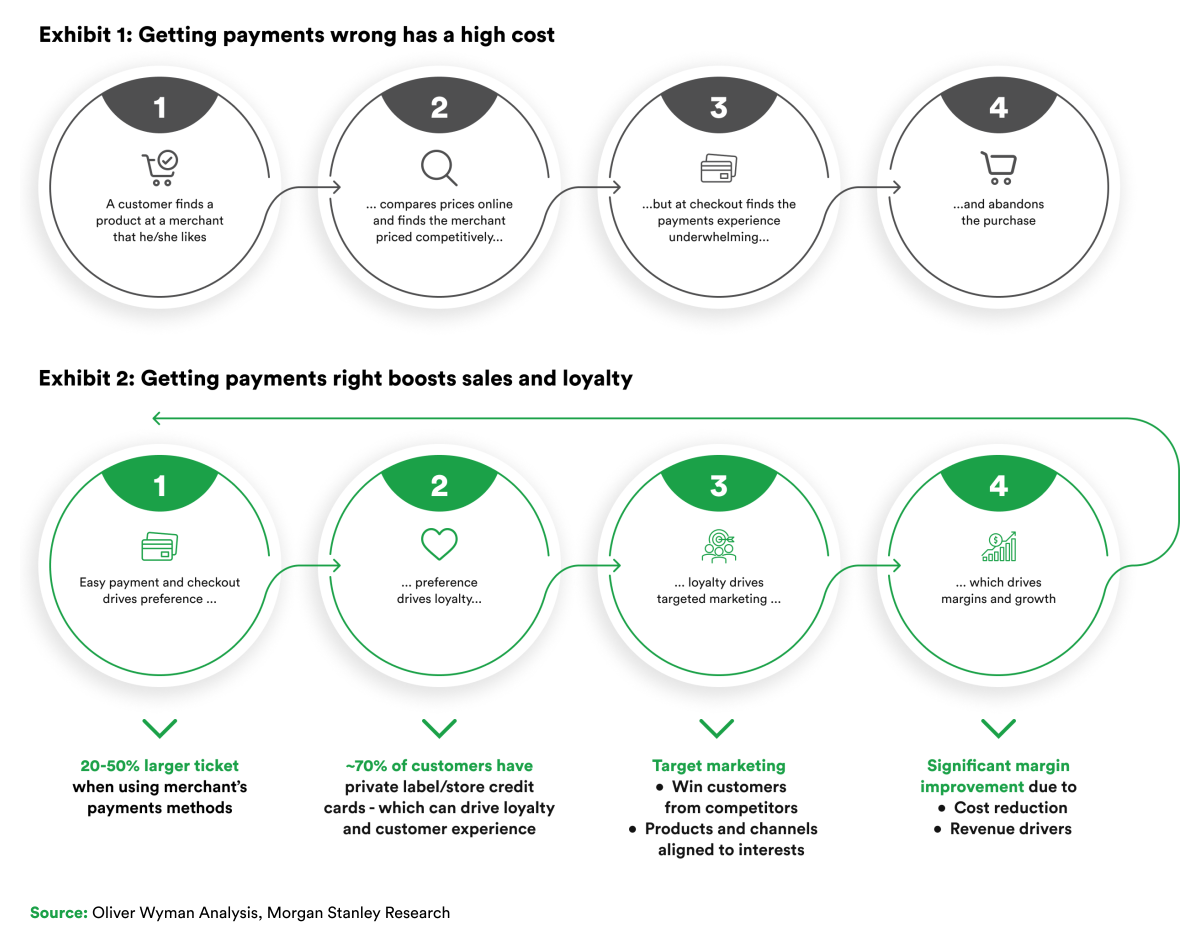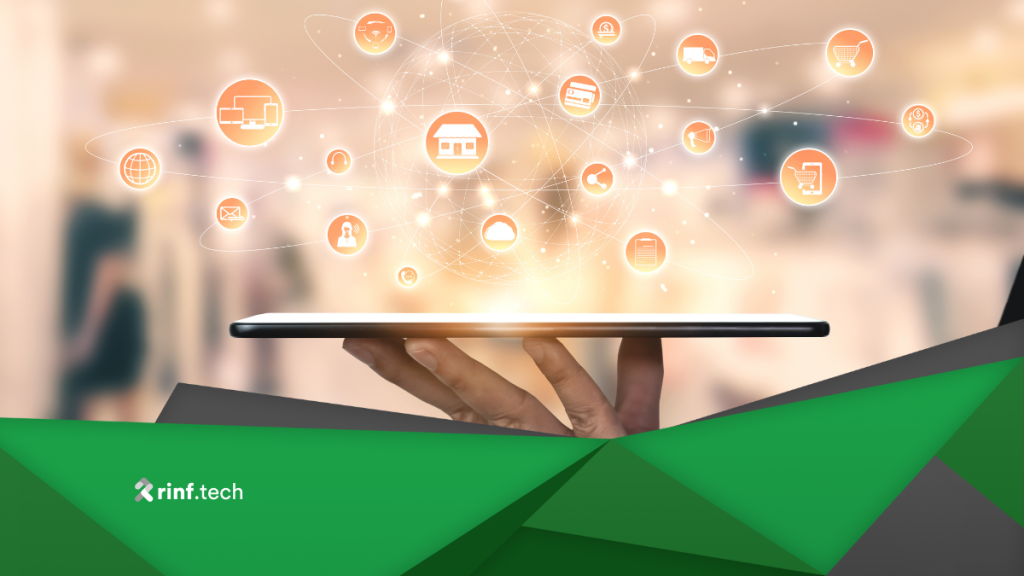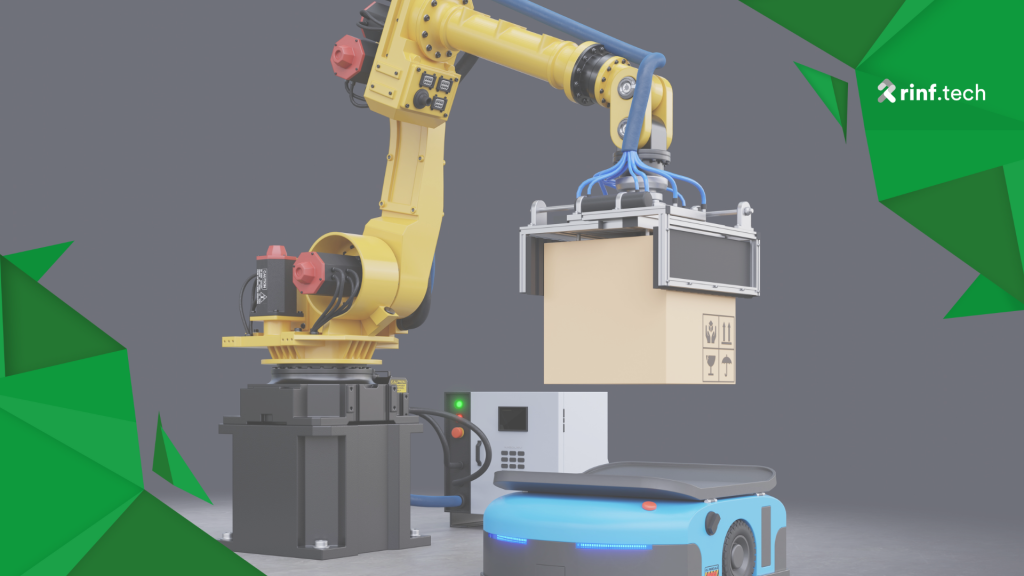
Omnichannel Retail: Technologies, Challenges, and Opportunities
This article explores omnichannel retail. It covers its advantages, the technology driving it, the implementation challenges companies face, and future trends.
Digital payment methods, which include mobile wallets and contactless payments, are becoming the norm rather than the exception, with their usage skyrocketing worldwide. The global mobile payment market is projected to grow from $3.84 trillion in 2024 to $27.81 trillion by 2032. Such trends highlight fintech’s vital role in modernizing the retail industry.
Fusing fintech and retail is more than just a trend; it’s a fundamental transformation reshaping the retail landscape on multiple fronts. This shift is marked by the adoption of advanced technologies like AI, blockchain, and data analytics, all used to create more personalized and secure shopping experiences. Retailers are increasingly relying on these innovations to meet the growing demands of tech-savvy consumers and stay competitive in a market that is rapidly moving towards digital-first solutions.
This article provides a comprehensive overview of how fintech innovations drive significant changes in the retail industry. As fintech continues to evolve, it presents both opportunities and challenges for the retail sector. Understanding and adapting to these changes is crucial for retailers who wish to thrive in this new digital era.
The evolution of digital payments and mobile wallets has significantly reshaped the retail industry, driving a shift towards faster, more secure, and more convenient payment methods.
The rise of contactless payments has been a game-changer. Fueled by the COVID-19 pandemic, which prompted the need for minimal physical contact, the adoption of contactless payment methods has surged globally. According to a study by Juniper Research, the total value of contactless transactions is expected to reach $15.7 Trillion Globally by 2029. This shift enhances the customer experience and allows retailers to process transactions more efficiently, reducing wait times and increasing customer satisfaction.
Biometrics is another area where fintech has significantly impacted retail payments. Integrating biometric authentication methods, such as fingerprint and facial recognition, into payment processes has added security and convenience. Companies like Mastercard have been pioneers in this space, with their “Identity Check” service, often called “selfie pay,” allowing customers to authenticate online purchases using facial recognition technology. This method has significantly reduced fraud, as it is much harder for criminals to replicate biometric data than traditional passwords or PINs.
Tokenization is another important innovation in securing retail transactions, playing a pivotal role in protecting consumer data during digital payments. Tokenization replaces sensitive payment information, such as credit card numbers, with a unique identifier or “token” that cannot be used outside of the specific transaction. This method drastically reduces the risk of data breaches and fraud, as the payment data is never exposed. Major payment processors like Visa and Mastercard have adopted tokenization as a standard practice, especially in mobile wallet transactions.
The rise of digital wallets and advancements in biometric authentication and tokenization have profoundly impacted the retail industry. These technologies provide a more secure and efficient payment process and enhance the overall shopping experience, making it more convenient and accessible for consumers. The widespread adoption of digital payments and wallets is a clear indication of the retail industry’s ongoing digital transformation, driven by the need to meet the evolving expectations of today’s consumers.
The “Buy Now, Pay Later” (BNPL) model has experienced a giant rise in popularity, fundamentally altering how consumers approach purchasing. BNPL services allow consumers to make purchases immediately while deferring payments over some time, often with little to no interest. This payment model has resonated particularly well with younger demographics, such as Millennials and Gen Z, who are usually cautious about credit card debt. The appeal of BNPL lies in its flexibility, allowing consumers to budget their spending more effectively without the burden of high-interest credit card debt.
Retailers have quickly integrated BNPL options into their checkout processes, recognizing the potential to increase sales and customer loyalty. Major retailers like Walmart, Amazon, and Target have partnered with BNPL providers to offer these services at checkout, both online and in-store. These partnerships have proven mutually beneficial, with BNPL services driving higher conversion rates and larger average order values. For example, Klarna reported that retailers offering their BNPL option see an increase in average order value by as much as 68%. Consumers are more likely to add higher-priced items to their cart when they know they can spread the payments over time.
The impact of BNPL on customer loyalty is another critical factor in its rapid adoption. Consumers who use BNPL services tend to return to the same retailers more frequently, drawn by the convenience and financial flexibility that BNPL offers. Furthermore, BNPL services often have built-in loyalty programs or rewards that enhance customer retention and satisfaction.
However, the rapid growth of BNPL services has also brought potential risks and regulatory scrutiny. It’s important to be cautious, as critics argue that the ease of access to BNPL services could lead to increased consumer debt, particularly among younger and financially inexperienced users. This has led to growing concerns about the need for stronger consumer protections and clearer regulations around BNPL offerings. Regulators have already begun to tighten oversight of the BNPL industry, requiring providers to conduct more rigorous credit checks and ensure greater transparency in their terms and conditions.
Despite these concerns, the BNPL market shows no signs of slowing down. The global BNPL market was valued at $378.3 billion in 2023 and is expected to grow at a CAGR of over 40% between 2024 and 2032. As the market expands, we can expect to see further innovations in how BNPL services are integrated into the retail experience.

The rise of data analytics has empowered retailers to understand better and predict customer behavior, allowing them to offer highly personalized shopping experiences. Retailers can gain deep insights into individual consumer preferences by leveraging vast amounts of data collected from various touchpoints, including online browsing history, purchase patterns, and social media interactions. This data-driven approach enables businesses to tailor their marketing strategies, product offerings, and promotions to meet each customer’s unique needs. For instance, global retail giants like Amazon and Netflix have perfected the art of personalization. Amazon’s recommendation engine, which suggests products based on a user’s browsing and purchasing history, generates approximately 35% of the company’s revenue.
AI and ML have become critical tools for personalized shopping experiences at scale. These technologies allow retailers to analyze customer data in real time, making it possible to offer personalized recommendations, targeted advertisements, and customized content. Beauty retailer Sephora uses AI to provide personalized product recommendations through its mobile app, which analyzes customer data and preferences to suggest items that best match their needs. These AI-powered solutions enable retailers to create more engaging and relevant customer experiences, ultimately driving higher conversion rates and increased customer loyalty.
Digital wallets and mobile payment platforms often incorporate features that allow customization based on individual spending habits. For example, apps like PayPal offer personalized cashback rewards and discounts tailored to users’ past purchases. This enhances the shopping experience and encourages repeat purchases, as customers feel rewarded for their loyalty.
Several retailers have successfully implemented data-driven strategies to enhance their personalized shopping experiences. A notable example is Starbucks, which uses its mobile app and loyalty program to collect data on customer preferences. This data is then used to deliver personalized offers and recommendations, such as suggesting a customer’s favorite drink during their usual purchasing time. The result is a highly customized experience that has helped Starbucks build a loyal customer base and increase sales.
This holistic approach to personalization is transforming the retail industry, creating new opportunities for growth and customer engagement.
As the retail industry continues to embrace digital transformation, the threat of fraud has become a significant concern, prompting retailers to invest heavily in advanced fraud prevention measures. The shift towards online shopping, mobile payments, and digital wallets has opened new avenues for cybercriminals to exploit vulnerabilities in payment systems and customer data storage. In 2023 alone, global retail fraud losses were estimated to reach $429 billion, highlighting the urgency for robust fraud prevention strategies. Retailers increasingly turn to fintech solutions to combat these threats, employing sophisticated tools that leverage AI and ML to detect and prevent fraudulent activities in real time.
AI and ML play a vital role in enhancing fraud detection and prevention in the retail sector by analyzing transactional data for patterns and anomalies. For example, AI-powered systems can monitor real-time transactions, flagging unusual activities such as multiple transactions from different locations or large purchases deviating from a customer’s typical spending habits. Companies like Stripe have implemented such systems to secure payment platforms, effectively reducing fraud rates and protecting merchants and consumers.
Strong cybersecurity measures are essential for protecting customer data in digital transactions, along with fraud detection. The retail industry is increasingly adopting encryption, secure payment gateways, and multi-factor authentication to safeguard customer information. Encryption ensures that data transmitted during a transaction is securely encoded and unreadable to unauthorized parties. For example, platforms like Apple Pay and Google Wallet use end-to-end encryption to provide additional security for mobile payments.
Multi-factor authentication (MFA) has also become a critical component of retail cybersecurity. By requiring users to verify their identity through multiple forms of authentication—such as a password, fingerprint, or a one-time code sent to their mobile device—MFA significantly reduces the risk of unauthorized access to accounts. The adoption of MFA has proven effective in preventing account takeovers and reducing the incidence of fraudulent transactions, contributing to a safer online shopping environment.
Empowerment through education is a key aspect of a comprehensive cybersecurity strategy. Beyond technological measures, educating customers about fraud prevention is essential. Consumers often serve as the first line of defense against fraud, and their awareness and vigilance are crucial in preventing cyberattacks.
Blockchain technology enhances transparency and efficiency in retail supply chain management by providing a decentralized ledger that records every transaction and movement securely. It meets increasing consumer and regulatory demands for transparency.
One of the most significant advantages of blockchain in retail is its ability to enhance product traceability and authenticity. For example, luxury brands like LVMH and Prada have begun using blockchain to combat counterfeiting by providing a digital certificate of authenticity that is recorded on the blockchain. This certificate can be accessed by consumers through a simple QR code scan, allowing them to verify the authenticity of their purchases. Similarly, the diamond industry has adopted blockchain to ensure that diamonds are ethically sourced.
Blockchain’s impact on supply chain transparency extends to the food and beverage industry, where it is being used to ensure food safety and quality. In collaboration with IBM, Walmart has implemented blockchain technology to trace the journey of food products through its supply chain. This initiative, known as the IBM Food Trust, allows Walmart to track the origin and journey of food items like leafy greens, reducing the time it takes to trace a product from days to mere seconds. This capability is crucial in the event of a foodborne illness outbreak, as it enables retailers to quickly identify and remove contaminated products from shelves, thereby protecting consumers and minimizing financial losses.
Blockchain technology is also crucial in improving supply chain efficiency and sustainability. By providing a single, immutable record of all transactions, blockchain reduces the need for intermediaries and streamlines processes, leading to faster and more cost-effective supply chains
Several retailers actively explore and implement blockchain applications to enhance their supply chains. For example, Carrefour, a French multinational retailer, has adopted blockchain to provide customers with detailed information about the origin and quality of their products. Using the Carrefour app, customers can scan a QR code on products such as chicken or milk to access information about the farm where the product was sourced, the production process, and the transportation journey.
Retailers that adopt blockchain are better positioned to meet consumer demands for transparency, authenticity, and sustainability, while also improving operational efficiency and reducing costs.
One of the key trends shaping the future of retail is the increasing integration of AI and ML into fintech solutions. These technologies are enabling retailers to provide highly personalized shopping experiences, automate customer service through AI-driven chatbots, and optimize inventory management.
Another emerging trend is the rise of decentralized finance (DeFi) and digital currencies, poised to disrupt traditional payment systems and offer new opportunities for retailers and consumers. Cryptocurrencies like Bitcoin and Ethereum are gaining traction as alternative payment methods, particularly among tech-savvy consumers who value digital currencies’ privacy, security, and decentralization. Additionally, central banks around the world are exploring the development of central bank digital currencies (CBDCs), which could further transform the retail payment landscape.
Collaboration between retailers and fintech companies will play a critical role in shaping the industry’s future. By partnering with fintech firms, retailers can leverage cutting-edge technologies and expertise to innovate and stay ahead of the competition. As fintech continues to evolve, we can expect to see more strategic partnerships between retailers and fintech companies, driving innovation and growth in the industry.
Retail’s future will also be influenced by the increasing importance of sustainability and ethical considerations in consumer purchasing decisions. Fintech can support retailers in meeting these demands by providing tools for greater transparency and accountability. Retailers like Patagonia and Everlane have already embraced these technologies to provide consumers with detailed information about the sustainability of their products, building trust and loyalty among eco-conscious shoppers. As sustainability becomes a key differentiator in the retail market, fintech solutions that enable retailers to track, report, and improve their environmental and social impact will be increasingly important.
The integration of fintech innovations into the retail sector is more than just a passing trend—it’s a significant transformation reshaping the industry on multiple fronts. From the widespread adoption of digital payment methods like mobile wallets and contactless payments to the rise of Buy Now, Pay Later (BNPL) services, fintech is fundamentally altering how consumers shop and how retailers operate. These innovations are driving greater efficiency, security, and personalization, which in turn enhances customer satisfaction and loyalty.
As digital payments become the norm and technologies such as AI, machine learning, and blockchain gain traction, retailers are finding new ways to engage with their customers and streamline their operations. Personalized shopping experiences powered by data analytics and AI are setting new standards in customer service, while advanced security measures like biometrics and tokenization are safeguarding transactions in an increasingly digital marketplace.
Moreover, the collaboration between retailers and fintech companies is proving essential in staying competitive in a rapidly evolving market. These partnerships are fostering innovation, allowing retailers to leverage cutting-edge technologies to meet the growing demands of tech-savvy consumers. The retail industry’s future will undoubtedly be shaped by ongoing developments in fintech, with sustainability and ethical considerations becoming increasingly important to consumers.
In this dynamic landscape, retailers that embrace fintech innovations will be well-positioned to thrive. By adopting these technologies, they can not only meet the evolving needs of their customers but also drive growth and maintain a competitive edge in the digital era. The convergence of fintech and retail is not just enhancing the shopping experience—it’s redefining the very fabric of the retail industry, paving the way for a more secure, efficient, and customer-centric future.
Partnering with an experienced software development provider, such as rinf.tech, can provide the expertise and support needed to successfully implement fintech solutions and drive long-term success.
Let’s talk.

This article explores omnichannel retail. It covers its advantages, the technology driving it, the implementation challenges companies face, and future trends.

In this article, we explore a current retail technology landscape and trends shaping the industry, retail tech use cases, as well as what the future holds for retail tech.

Revisiting some basics about retail demand forecasting and inventory management solutions.